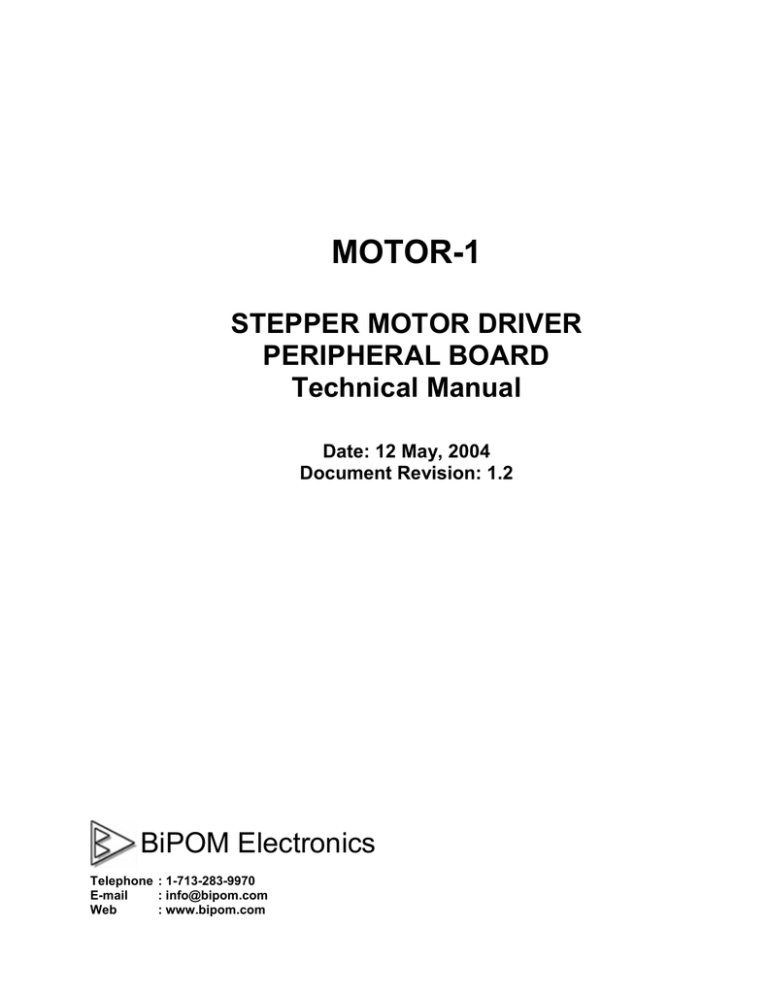
MOTOR-1
STEPPER MOTOR DRIVER
PERIPHERAL BOARD
Technical Manual
Date: 12 May, 2004
Document Revision: 1.2
BiPOM Electronics
Telephone : 1-713-283-9970
E-mail
: info@bipom.com
Web
: www.bipom.com
© 2004 by BiPOM Electronics. All rights reserved.
MOTOR-1 Technical Manual. No part of this work may be reproduced in any manner without written permission of
BiPOM Electronics.
All trademarked names in this manual are the property of respective owners.
WARRANTY:
BiPOM Electronics warrants MOTOR-1 for a period of 1 year. If the board becomes defective during this period,
BiPOM will at its option, replace or repair the board. This warranty is voided if the product is subjected to physical
abuse or operated outside stated electrical limits. BiPOM Electronics will not be responsible for damage to any
external devices connected to MOTOR-1. BiPOM Electronics disclaims all warranties express or implied
warranties of merchantability and fitness for a particular purpose. In no event shall BiPOM Electronics be liable for
any indirect, special, incidental or consequential damages in connection with or arising from the use of this
product. BiPOM Electronics’ liability is limited to the purchase price of this product.
2
TABLE OF CONTENTS
1. OVERVIEW
4
2. SPECIFICATIONS
4
3. EXPANSION BUS
5
4. OPERATING MODES
6
5. MOTOR AND EXTERNAL POWER SUPPLY CONNECTION
8
6. BOARD LAYOUT
9
7. SCHEMATICS
10
3
1. Overview
Stepper motor driver peripheral board is a peripheral board for the MINI-MAX/51, MINI-MAX/908, MINI-MAX/PIC,
MINI-MAX/11-A and PRO-MAX series of micro-controller boards. It offers complete control and drive for a fourphase unipolar stepper-motor with continuous output current ratings to 1.25 A per phase (1.5 A startup) and 35 V.
It requires external power source to drive motor.
2. Specifications
MOTOR-1 board has the following configuration:
· Integrated unipolar stepper motor controller UCN5804 (U1).
· 7-pin terminal block for external power source and motor connections (X1).
· 4-pin connector for external control (J2).
· Jumper switch to select a port pin to control STEP line (JP6…JP9)
· Jumper switch to select a port pin to control DIRECTION line (JP10…JP15)
· Jumper switch to select a port pin to control OE line (JP3…JP5,JP16)
· Mode select (1 PHASE / 2 PHASE and STEP / HALF-STEP) jumpers (JP1, JP2)
· 20-pin connector to a variety of micro-controller boards.
· Dimensions are 2.35 X 2.40 inches (5.97 X 6.10 centimeters).
· Mounting holes of 0.125 inches (3.18 millimeters) are on four corners.
· 0° - 70° C operating, -40° - +85° C storage temperature range.
4
3. Expansion bus
The 16 control pins and 5 Volt power supply pins are available on the 20-pin connector (J1) for interfacing to
existing micro-controller boards. MOTOR-1 board can be connected to a host board either as a piggyback
daughter-board using standoffs or can be placed away from the host board using a 20-wire ribbon cable (Part #:
EXPCABLE-6). Table 1 shows the pin assignments for the connector.
Input Connector (J1)
Signal
Pin
Pin
Signal
P3.0
20
19
P3.1
P3.2
18
17
P3.3
P3.4
16
15
P3.5
P3.6
14
13
P3.7
P1.0
12
11
P1.1
P1.2
10
9
P1.3
P1.4
8
7
P1.5
P1.6
6
5
P1.7
VCC (+5V)
4
3
GND
VCC (+5V)
2
1
GND
Table 1
5
4. Operating modes
Internal power-on reset circuitry resets outputs in the two-phase drive format to the on state with initial application
of the logic supply voltage. After reset, the circuit then steps according to the tables.
The outputs will advance one sequence position on the high-to-low transition of the STEP INPUT pulse. The
DIRECTION pin determines the rotation sequence of the outputs. Note that the STEP INPUT must be in the low
state when changing the state of ONE-PHASE, HALF-STEP, or DIRECTION to prevent erroneous stepping.
HALF-STEP and ONE-PHASE jumpers will determine the drive format (one-phase, two-phase, or half-step).
The wave-drive format consists of energizing one motor phase at a time in an A-B-C-D (or D-C-B-A) sequence.
This excitation mode consumes the least power and assures positional accuracy regardless of any winding in
balance in the motor.
WAVE-DRIVE SEQUIENCE
Jumpers: Half Step – present, Phase – absent
STEP
RESET
A
B
C
D
ON
OFF
OFF
OFF
1
ON
OFF
OFF
OFF
2
OFF
ON
OFF
OFF
3
OFF
OFF
ON
OFF
4
OFF
OFF
OFF
ON
Table 2
Two-phase drive energizes two adjacent phases in each detent position (AB-BC-CD-DA). This sequence mode
offers an improved torque-speed product, greater detent torque, and is less susceptible to motor resonance.
TWO-PHASE DRIVE SEQUIENCE
Jumpers: Half Step – present, Phase – present
STEP
RESET
A
B
C
D
ON
OFF
OFF
ON
1
ON
OFF
OFF
ON
2
ON
ON
OFF
OFF
3
OFF
ON
ON
OFF
4
OFF
OFF
ON
ON
Table 3
6
Half-step excitation alternates between the one-phase and two-phase modes (A-AB-B-BC-C-CD-D-DA),
providing an eight-step sequence.
HALF-STEP DRIVE SEQUIENCE
Jumpers: Half Step – present, Phase – present
STEP
RESET
A
B
C
D
ON
OFF
OFF
ON
1
ON
OFF
OFF
OFF
2
ON
ON
OFF
OFF
3
OFF
ON
OFF
OFF
4
OFF
ON
ON
OFF
5
OFF
OFF
ON
OFF
6
OFF
OFF
ON
ON
7
OFF
OFF
OFF
ON
8
ON
OFF
OFF
ON
Table 4
7
5. Motor and external power supply connection
Figure 1 shows how to connect a stepper motor to the board.
External power supply to drive the motor should be connected to VCC
and GND terminals of X2. It should have enough load capability to drive
used motor.
Figure 1
8
6. Board Layout
Figure 2 shows positions of major components, connectors and terminals on the MOTOR-1 board.
Expansion
Connector(J1)
Jumpers to select
port for “OE”,
“STEP” , and
“DIRECTION”
4-pin
connector
for external
control (J2)
Step /
Half-step
Jumper
(JP2)
Resettable
Fuse (F1)
1 Phase /
2 Phase
Jumper
(JP1)
Stepper-motor and
external power
supply terminal
Stepper-motor
translator/driver
(U1)
Figure 2
9
7. Schematics
Figure 3
10




